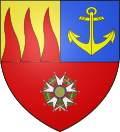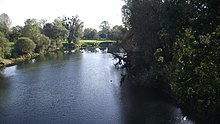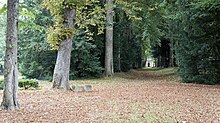Bazeilles
Bazeilles | |
|---|---|
 The CSSA Club Sportif Sedan Ardennes in Bazeilles | |
| Coordinates: 49°40′41″N 4°58′38″E / 49.6781°N 4.9772°E | |
| Country | France |
| Region | Grand Est |
| Department | Ardennes |
| Arrondissement | Sedan |
| Canton | Sedan-3 |
| Intercommunality | CA Ardenne Métropole |
| Government | |
| • Mayor (2020–2026) | Francis Bonne[1] |
Area 1 | 37.44 km2 (14.46 sq mi) |
| Population (2021)[2] | 2,502 |
| • Density | 67/km2 (170/sq mi) |
| Time zone | UTC+01:00 (CET) |
| • Summer (DST) | UTC+02:00 (CEST) |
| INSEE/Postal code | 08053 /08140 |
| Elevation | 152–238 m (499–781 ft) (avg. 156 m or 512 ft) |
| 1 French Land Register data, which excludes lakes, ponds, glaciers > 1 km2 (0.386 sq mi or 247 acres) and river estuaries. | |
Bazeilles (French pronunciation: [bazɛj]) is a commune in the Ardennes department in the Grand Est region of northern France.[3] On 1 January 2017, the former communes of Rubécourt-et-Lamécourt and Villers-Cernay were merged into Bazeilles.[4] On 1 January 2024, the former commune of La Moncelle was merged into Bazeilles.[5]
The inhabitants of the commune are known as Bazeillais or Bazeillaises.[6]
The commune has been awarded three flowers by the National Council of Towns and Villages in Bloom in the Competition of cities and villages in Bloom.[7]
Geography
Bazeilles is located some 4 km south-east of Sedan and 2 km west of Douzy. Access to the commune is by Route nationale 43 (N43) from Sedan in the west which passes through the north of the commune and changes to the D8043 before continuing east to Douzy. Exit ![]() 3 Balan lies within the commune which leads to the D764 that goes south to the village. The N43 also links with the beginning of the N58 in the commune which goes north. Other access roads include the D8043A from Balan in the north-west which goes to the village then continues east to join the D8043. The D129 comes from Daigny in the north and passes through the village before continuing south to Remilly-Aillicourt. The D17 from Balan passes through the commune just north of the village and continues east. A railway passes through the south of the commune from east to south-west with no station in the commune. The next station to the east is at Carignan and the next to the west is at Sedan. The commune has a significant sized urban are and a large industrial estate with a very large Unilin plant[citation needed]. The rest of the commune is farmland.[8][9]
3 Balan lies within the commune which leads to the D764 that goes south to the village. The N43 also links with the beginning of the N58 in the commune which goes north. Other access roads include the D8043A from Balan in the north-west which goes to the village then continues east to join the D8043. The D129 comes from Daigny in the north and passes through the village before continuing south to Remilly-Aillicourt. The D17 from Balan passes through the commune just north of the village and continues east. A railway passes through the south of the commune from east to south-west with no station in the commune. The next station to the east is at Carignan and the next to the west is at Sedan. The commune has a significant sized urban are and a large industrial estate with a very large Unilin plant[citation needed]. The rest of the commune is farmland.[8][9]
The Meuse river forms the south-western border of the commune as it flows north-west to eventually join the Hollands Diep at Lage Zwaluwe (Netherlands). The Chiers river flows from the north-east forming part of the south-eastern border before joining the Meuse in the south-eastern corner of the commune. The Ruisseau de la Givinne flows from the north through the centre of the commune before joining the Meuse in the south.[8][9]
Toponymy
The name Bazeilles would have appeared in the 6th or 7th century and comes from a variation of the Latin word Basilicatum meaning "church".
Bazeilles appears as Bazeille on the 1750 Cassini Map[10] and the same on the 1790 version.[11]
History
Middle Ages
In the 13th century Bazeilles was a small lordship dependent on the Abbey of Mouzon and the Reims Cathedral before being united with the lordship of Sedan-Balan under the yoke of Gilles II of Hierges. The new lordship of Sedan-Balan-Bazeilles become the "starting point" of the future Principality of Sedan.[12]
It was possible that a small castle guarded the road to Douzy and Yvois (Carignan) and would have been in the northern part of the park of the current Chateau of Orival along the Givonne (rue du General Lebrun).
From 1560 to 1642 Bazeilles was part of the Principality of Sedan.
Franco-Prussian War
Related article: Battle of Sedan.



During the Battle of Bazeilles on 1 September 1870 the commune was the scene of intense fighting between units of French marines and Bavarian regiments. Under the command of Commander Lambert and Captains Aubert, Bourgey, Delaury, Picard and the Blue Division, in the Bourgerie Inn, a few hundred men and officers resisted until their ammunition was completely exhausted. This moment of history was illustrated by the famous painting by Alphonse-Marie-Adolphe de Neuville painted in 1873: The last cartridges and conserved in Bazeilles in the House of the last cartridge.
During the battle, French civilians actively participated by firing on Bavarian troops and tending to the wounded. Angered by the casualties the civilians inflicted, the Bavarian soldiers killed many of them, setting fire to houses from which the shots were fired. By midday, the whole village was on fire.[13] Captured Franc-tireur partisans, along with other civilians who were considered unlawful combatants, were later executed. Although French propaganda showed massacres of men, women and children, an official French investigation found that only 39 civilians from Bazeilles died.[14] An additional 150 people (10% of the village population) died from injuries in the subsequent months.
Bazeilles was awarded the Legion of Honour on 9 October 1900. Bazeilles is one of the communes where is the action of the novel "La débâcle" by Emile Zola is set.
Second World War

During the Second World War and during the Phoney War, the command post of the 5th Light Cavalry Division under General Jacques-Marie Chanoine was established in Bazeilles.[15] Then the Battle of France was triggered on 10 May 1940 and the Cavalry Division left for Belgium. A few days later Bazeilles was taken by the 10th Panzer Division under Ferdinand Schaal. Bazeilles was the initial base for the Schützen-Regiment 69 (Infantry from the 10th Panzer-Division), who, on the afternoon of 13 May 1940, launched an attack to cross the Meuse. The attempt was thwarted by the French artillery.[16] At the same time an attempt by the Schützen-Regiment 86 (the other infantry regiment of the 10th Panzer Division) in front of Wadelincourt succeeded and the Schützen-Regiment 69 then swerved then to that sector.[17]
Heraldry
 |
Blazon: Party per fess, at 1 party per pale Or, with 3 points of flame Gules and Azure, an anchor of Or; at 2 Gules, a Legion of Honour proper.
|
Administration

| From | To | Name | Party | Position |
|---|---|---|---|---|
| 1912 | 1945 | Alexandre Abd-El-Nour | Independent Radicals | Doctor |
| 1973 | 1989 | André Etchegoimberry | Butcher | |
| 1995 | 2014 | Pierre Sulfourt | General Councillor (1992–2004) | |
| 2014 | 2020 | Guy Lepage | ||
| 2020 | 2026 | Francis Bonne |
Demography
In 2017 the commune had 2,394 inhabitants.
|
| ||||||||||||||||||||||||||||||||||||||||||||||||||||||||||||||||||||||||||||||||||||||||||||||||||||||||||||
| Source: EHESS[19] and INSEE[20] | |||||||||||||||||||||||||||||||||||||||||||||||||||||||||||||||||||||||||||||||||||||||||||||||||||||||||||||

Culture and heritage




Civil heritage
- The Home of the last cartridge (museum), the scene of fighting, during the Franco-Prussian War of 1870, held by the Blue Division. This place has become a memorial site and museum of French Marine Troops.
- The French and Prussian Ossuary monument in the communal cemetery.
- The Chateau of Orival: built in 1750 for Louis Labauche, a draper from Sedan, sometimes attributed to the architect Emmanuel Héré de Corny and Jean Lamour for the ironwork. These attributions are not reinforced by any concrete evidence and, according to Jean-Lucien Guenoun, "the rusticity of the treatment of carved windows suggests less illustrious artisans"[21] The chateau was the summer residence of Louis Labauche.
The commune has a number of buildings and sites that are registered as historical monuments:
- A Pasta Factory (1911)
 [22]
[22] - The Chateau of Turrenne (16th century).
 [23] Only the portal remains of the old building. Now a farmhouse.
[23] Only the portal remains of the old building. Now a farmhouse. - A Chateau (18th century)
 [24]
[24] - The Chateau of Orival Park
 [25]
[25] - The Chateau of Montvillers (1770)
 [26] built for John Abraham Poupart de Neuflize, a draper from Sedan, by the King's architect Claude Jean-Baptiste Jallier de Savault. Now the training centre of the CSSA Club Sportif Sedan Ardennes.
[26] built for John Abraham Poupart de Neuflize, a draper from Sedan, by the King's architect Claude Jean-Baptiste Jallier de Savault. Now the training centre of the CSSA Club Sportif Sedan Ardennes.
Notable people linked to the commune
- Alexandre Abd-El-Nour (1869–1956) : Doctor, Mayor of Bazeilles, first president of the Automobile Club Ardennais and first presidentet of the Aero Club of Ardennes.
- Erik Haldorf, painter, born in 1937 in Bazeilles.
See also
Bibliography
Jacques Rousseau: Bazeilles, origins and mutations, 2002. ISBN 2-84458-008-4.
References
- ^ "Répertoire national des élus: les maires". data.gouv.fr, Plateforme ouverte des données publiques françaises (in French). 2 December 2020.
- ^ "Populations légales 2021" (in French). The National Institute of Statistics and Economic Studies. 28 December 2023.
- ^ INSEE commune file
- ^ Arrêté préfectoral 15 June 2016 (in French)
- ^ Arrêté du 14 septembre 2023 portant création de la commune nouvelle de Bazeilles, retrieved 4 January 2024
- ^ Inhabitants of Ardennes (in French)
- ^ Competition for Towns and Villages in Bloom website Archived December 10, 2014, at the Wayback Machine (in French)
- ^ a b c Bazeilles on Google Maps
- ^ a b Bazeilles on the Géoportail from National Geographic Institute (IGN) website (in French)
- ^ Bazeille on the 1750 Cassini Map
- ^ Bazeille on the 1790 Cassini Map
- ^ 2000 years of History of the Sedanais, P. Congar, 1967 (in French)
- ^ Schmidthuber (Hrsg.): Der deutsch-Französische Krieg 1870/71 unter besonderer Berücksichtigung der Antheilnahme der Bayern. Auszug aus dem Generalstabswerk, J. F. Rietsch, Landshut 1900, S. 90
- ^ Jan N. Lorenzen: The great battles – myths, people, stories, Routledge, 2006, Frankfurt, p.162 According to other data, 31 civilians were killed, wounded, or were missing due to direct fighting. Dennis A. Showalter: The face of modern warfare. Sedan 1st, and second In September 1870. Stig Förster, Markus Pohlmann, Dierk Walter (ed.): battles in world history. Salamis to Sinai. Munich 2001, p 239
- ^ Jean-Yves Mary, The Corridor of Panzers, Vol. I, Bayeux, Heimdal, 2009, p. 34
- ^ Jean-Yves Mary, The Corridor of Panzers, Vol. I, Bayeux, Heimdal, 2009, p. 243
- ^ Jean-Yves Mary, The Corridor of Panzers, Vol. I, Bayeux, Heimdal, 2009, p. 250
- ^ List of Mayors of France (in French)
- ^ Des villages de Cassini aux communes d'aujourd'hui: Commune data sheet Bazeilles, EHESS (in French).
- ^ Population en historique depuis 1968, INSEE
- ^ Jean-Marie Pérouse de Montclos (dir.), The Heritage Guide. Champagne Ardenne, Paris, Hachette, 1995, p. 104 ISBN 2-01-020987-7 (in French)
- ^ Ministry of Culture, Mérimée IA08000326 Pasta Factory (in French)
- ^ Ministry of Culture, Mérimée PA00078341 Chateau of Turrenne (in French)
- ^ Ministry of Culture, Mérimée PA00078340 Chateau (in French)
- ^ Ministry of Culture, Mérimée IA080000212 Chateau of Orival Park (in French)
- ^ Ministry of Culture, Mérimée IA08000327 Chateau of Montvillers (in French)




